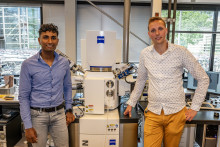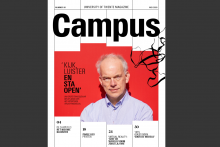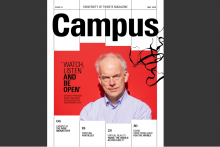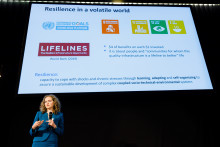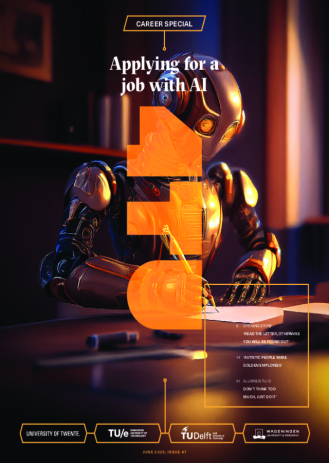In total, seventeen research proposals were submitted to 4TU by scientists from the four technical universities. Five of these were selected as promising ‘High Tech for a sustainable future.’ Three of those five studies are run by UT professors: Tatiana Filatova, Herman van der Kooij and Michel Versluis. Although their research fields are nothing alike, they all have high expectations of the impact their research will have on the challenges our society faces. Current experts from all associated universities are not the only ones who will work on these issues; the programme also makes it possible to bring in young talent. It is expected that businesses and social organisations will be happy to collaborate with a ‘thinktank’ with so much brain power – more so than with an individual university.
The research programme will last five years and young talent is attracted to safeguard the continuation of the research and education in the future. The three UT professors are determined to make the collaboration a success. Time and money are not an issue and all three have felt a strong willingness to collaborate from the other technical universities. Less overlap, more access to each other’s specific knowledge, greater efficiency: these are just a few examples of the benefits of this joint approach. The collaboration with people with practical experience guarantees that the research ties in well with today’s major issues. Everyone involved in the project shares the same goal: to conduct research that will have a genuine impact on our daily lives. The three research leaders explain how they plan to realise that.
4TU
4TU is the federation of four leading Dutch technical universities: Delft University of Technology (TU Delft), Eindhoven University of Technology (TU/e), the University of Twente (UT), and the Wageningen University and Research Centre (WUR). It aims to maximize innovation by concentrating the strengths in research, education and knowledge transfer.
Tatiana Filatova
Resilience Engineering
It is perhaps the most comprehensive research field of all 4TU projects: designing for a resilient world. That is why research leader professor Tatiana Filatova sees so many opportunities in the collaboration with other knowledge institutes and businesses. ‘The Netherlands has achieved worldwide renown with its wealth of knowledge of technology and design. However, the knowledge possessed by universities and businesses is often fragmented at the moment. By combining our strengths, this knowledge can have a far greater impact on our society.’
Our world is vulnerable: to natural disasters, terrorist attacks and cybercrime, but also to smaller disruptions such as power outages. In the past, an incident was often contained locally, but as systems become increasingly complex, a single incident can have a domino effect that leads to far greater consequences. Consider the collapse of the financial markets, the effects of this year’s storm on the transport sector and the consequences of a major power outage for telecommunication and healthcare facilities. ‘We can minimise the risk of a disaster, but it is impossible to avoid it entirely. There is always a slight chance that things will go wrong. We have to keep that in mind when we design our cities and regions. It is possible to design our society in such a way – on a technical and social level – that a system is fully operational again as soon as possible after an incident. Even better: it can emerge stronger and more resilient. We conduct research into that design method.’
'Our world is vulnerable'
‘We are not out to make people afraid of what might happen; rather, we rely on the resilience of systems. How can we design them in such a way that they do not collapse entirely in the event of a hurricane or a heatwave? We do not deal solely with major disasters either. For example, one of our partners is the Vechtstromen Water Authority, which wants to know how to better prepare the region for periods of extreme drought.’
For five years, ‘Resilience’ will be one of the largest research themes of 4TU. In addition to forty-three professors, sixteen new talents will also participate in this study and collaborate closely with circa 100 Resilience Fellows from the world of business, students and postgraduates. The programme is supported by Henk Ovink, the special ambassador of International Water Affairs, major industrial partners and pioneers in the field of Resilience Engineering, such as ETH Zurich-Singapore.
Resilience should be an important theme during, for instance, the design and realisation of a new energy network or the design of a new residential block or business park. The research’s primary goal is to ingrain this theme in the minds of the parties involved. It will also look for parameters with which to measure the resilience of systems. ‘Only by clearly recording the practical effects can you develop a standardised definition of what exactly a resilient city or infrastructure is. Thirdly, we want clarity about policies and regulations. What can the government impose? How can you make sure that sectors that have been decentralised by the government, such as the energy sector, are still set up in this new, resilient manner?’
Filatova will be satisfied when the research results have an actual impact on our society. ‘We are not after individual successes. Our primary concern is finding a way to make the world more resilient in the face of all manner of hardship.’
Herman van der Kooij
Robots with a soft touch
Robots can do a whole lot, but they are not known for their softness and suppleness. For some applications, those properties would come in quite handy. ‘When a robot is used in the healthcare sector, for example to lift people, it would be great if it feels soft to the touch, like a real human body. A soft and supple robot is also less prone to damage. That is important when you use a robot for medical examinations such as an endoscopy, but also in the horticultural sector when handling delicate fruits,’ says Herman van der Kooij. That is why finding the best talents in the new field of soft robotics is one of the 4TU projects.
At the moment, robots are constructed almost like Legos: using hard components that are controlled by sensors and motors. Soft robotics involves much more than putting a soft coating around all those technical bits. ‘If you look at nature, you will see that many organisms do not have a skeleton. That makes species like the earthworm much more flexible. Combining that flexibility with strength is like trying to replicate the structure of muscular tissue. That requires research into materials that, like a muscle, can change their length or shape. Perhaps these materials can come from a 3D printer. These new robots are inspired as much by technology as by biology, where every part of an organism functions in an integrated manner,’ Van der Kooij explains.
'These new robots are inspired as much by technology as by biology'
Because the four technical universities want to collaborate on this project, they can also invest in it together and prevent overlap in their research. Attracting new and promising talent to this innovative field offers the advantage of starting with only new people who, although they each belong to a different university, are primarily part of the bigger picture. ‘It will be an entirely new talent pool. We are looking for ambitious, promising individuals with excellent cooperation skills. It is easier to approach businesses together as 4TU than on our own. We also expect it to be easier to acquire funding when we work together.’
Michel Versluis
Precision Medicine
Although he does not want to get ahead of himself, professor Michel Versluis, leader of the Precision Medicine research programme, has high hopes for the improvements that the collaboration between the four technical universities will bring to the healthcare sector. ‘With more precise diagnoses, it will be possible to achieve far better results.’
To make such a precision diagnosis, artificial intelligence (deep learning) is applied to the results of an MRI scan, a CT scan and a biopsy. ‘Our challenge is to feed the right physical, biological and physiological data into the computer. That makes it possible to interpret the results of various studies in a way that even the best radiologist in the world cannot match.’
In addition to improved precision and fewer faulty diagnoses, that will also save time during surgical procedures. ‘A computer will soon be able to predict the optimal place to cut to remove a tumour in its entirety with clean cuts and without any functional side effects. Particularly with such conditions as tongue cancer or a brain tumour, accuracy is paramount. By having a computer process the data from millions of existing images, deep learning creates a far more accurate picture that can be presented to the surgeon in real time during a procedure. Furthermore, you can combine the results of different studies: during a procedure, it is not only important to know where the disease is located, but also where the blood vessels are, how elastic the surrounding tissue is, etc. In the future, you might even be able to use these results to control surgical robots. First, however, we want to utilise the computational power of artificial intelligence to improve the accuracy of diagnoses and develop better personal treatment plans.’
The collaboration between eighteen researchers from the four universities results in a wealth of highly diverse knowledge and expertise. Additionally, seven talented young researchers and seven postgraduates are brought in. The five-year study includes a close collaboration with clinics and manufacturers of medical equipment, such as Philips. ‘During such a large-scale joint research project, people must be willing to collaborate – with other faculties, other universities, businesses and clinics. Everyone definitely has that drive to achieve a breakthrough, because precision diagnostics ties into all of our lines of research. That focus keeps everyone sharp.’






